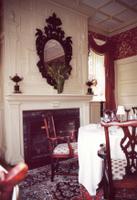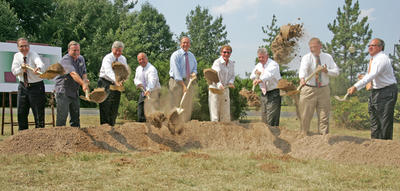 Photo by William M. Dowd
Photo by William M. Dowd
LAKE GEORGE, NY -- The topography around Lake George masks as much as it reveals.
Once past the fetching garishness of Lake George Village heading toward Bolton Landing on Route 9N -- the winding, tree-lined road locally known as Lake Shore Drive, you'll find a hodgepodge of log cabin guest colonies, Adirondack-style lodges and private homes existing cheek-by-jowl.
They are the obvious. But down the hills that slope to the exquisite lake are several former mansions converted over the years to guest lodging, the remnants of a level of luxury once commonly referred to here as Millionaire's Row.
Take the Queen Anne-style stone structure built in 1898 for Brooklyn lawyer Edward Morse Shepard as a lakeside vacation retreat. Once patrons navigate down a steep, winding drive, the formerly hidden three-story edifice looms into view.
This is the Inn at Erlowest.
It has gone by various names bestowed by various owners -- Erlowest, Leffingwell Palace, Sunset Castle and back to Erlowest when it came under the ownership of David and Cheryl Kenny last summer.
There are many gems here, from rolling lawns to a lakeview veranda to a library-style bar and four dining rooms.
Those rooms are studies in elegance -- coffered ceilings, rich draperies, small avian sculptures on the casement window sills and sparkling Spiegelau glassware on the tables.
But it is what goes on in the kitchen under chef Matthew Secich that makes Erlowest a wonder.
Secich is an eclectic Ohioan whose background includes time as a college lacrosse player and a U.S. Army cavalry scout as well as a student and a chef at various stops in the United States, France and England. Don't try to pigeonhole his style. He works on whim and the availability of local food supplies.
"In the kitchen," he says, "we use no recipes. I draw a picture and we create a new dish."
There are several ways of seeing those creations: two separate seven-course tasting menus ($79 per person) and an a la carte list, all of which change daily, or a special session in The Chef's Table Room adjacent to the kitchen where Secich gives vent to his creative flow through 8 to 12 courses ($129 per person).
Constant Companion and I had selected the vegetable tasting menu (the a la carte menu and the grand tasting include meat and fish items), with a $55 wine pairing option.
Erlowest's 264-label wine list contains a wide selection that runs the gamut in price and vintage from a 1961 Chateau Margaux ($2,770) to a 2002 Houchart Cotes de Provence ($20). Between those extremes are nearly 100 labels priced below $100.
Even though tastings allow for only small amounts of wine, in this case the add-on is worth the experience. Chef Secich and his staff have done an exemplary job in marrying their produce with excellent vintages.
After an amuse bouche of julienned Gorgonzola and apple and diced shallot, we were on to the seven tiny tastings, each exquisitely arranged on different shaped platters and serving pieces, each with a taste of its own wine.
A velvety chilled pea soup was dotted with a small scoop of chocolate mint ice cream -- not the ice cream store flavoring, but the chocolate mint herb -- and paired with a cleansing, nonvintage Gaston-Chiquet brut champagne.
Vegetables a la Provencal avoided the cliche tomato-garlic-oregano combination, thanks to the inclusion of licorice-like fennel and a taste of a sweet 2003 Domaine Pastou Sancerre from France's Loire Valley.
Our third course was an elegant arrangement of miniscule wild strawberries and reed-slender wild asparagus shoots with a balsamic drizzle, abetted by a crisp 2003 Olivier Leflaive St. Aubin 1er Cru white Burgundy.
The second portion of the meal was heartier, with rich, full-bodied wines that would go just as well with meat dishes.
A quartet of fingerling potatoes was roasted in salt, split and stuffed with Reblochon -- a French cheese made from whole, unpasteurized milk -- then dabbed with wilted spinach. It was paired with a 2000 La Braccesca Montepulciano, carrying red fruit and licorice notes.
Then came a trio of savory mushroom mixes that obviated any need for meat, the tender chanterelles, trumpet royals and mousserons paired with an inky-red Mas de Gourgonnier Reserve Les Baux de Provence, powerful with black cherry notes.
A cleansing finish came from two elements: a salad of spring baby lettuces with Blue Ledge chevre and a vaguely, but pleasingly, astringent 2001 Domaine Jean-Luc Dubois Clos Margot white Burgundy; then, a strawberry soup dotted with a touch of fiddlehead fern ice cream and joined by a 2003 La Spinetta Moscato d'Asti, a low-alcohol little bubbly that completed the beverage circle.
Secich is a clever kitchen artist with a young staff who may not know it, but they are getting the training of a lifetime.
UPDATE
Since this report was written, Secich resigned from Erlowest to venture elsewhere. He has been succeeded by his very capable No. 2, Ray Bohmer, who continues the Secich-style menu.
To Dowd's Spirits Notebook latest entry.
To Dowd's Wine Notebook latest entry.
To Dowd's Brews Notebook latest entry.
Back to Dowd's Bar Blog home page.




